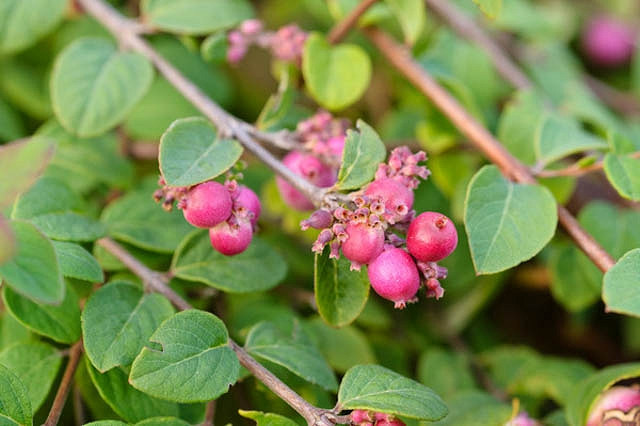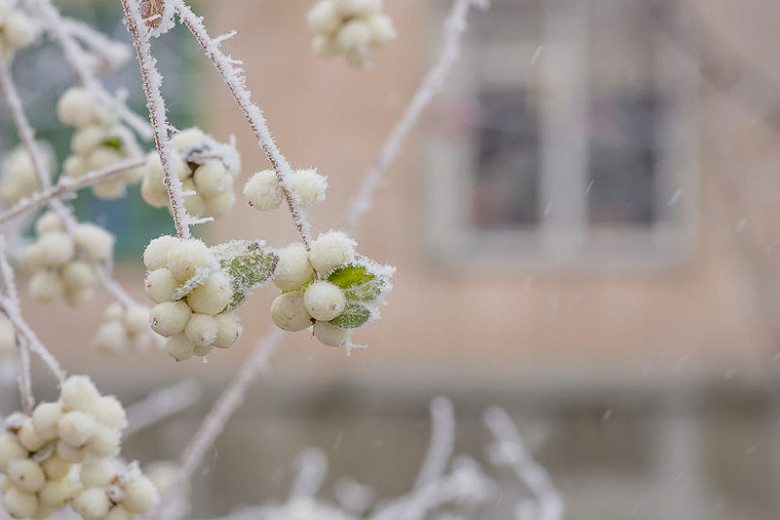Symphoricarpos x chenaultii Hancock (Snowberry)
Noted for its excellent ability to cover ground and smother weeds, Symphoricarpos x chenaultii ‘Hancock’ (Snowberry) is a low, spreading, deciduous shrub with arching, rooting branches that is amazingly adaptable and undemanding.
Noted for its excellent ability to cover ground and smother weeds, Symphoricarpos x chenaultii 'Hancock' (Snowberry) is a low, spreading, deciduous shrub with arching, rooting branches that is amazingly adaptable and undemanding. In late summer, a profusion of small, bell-shaped, pink flowers are borne at the tips of the branches. Inconspicuous, they are of great interest to butterflies, bees, and pollinators. The flowers are followed by abundant and attractive clusters of white fruits speckled with rosy red that persist well into winter. Birds do enjoy them in the winter months. The dense foliage of small, ovate bluish green leaves remains attractive from spring to frost.
- Grows at a vigorous rate, up to 1-2 ft. tall (60-90 cm) and 5-10 ft. wide (150-300 cm) with a spreading, cushion-forming habit. 'Hancock' Snowberry suckers profusely and sends out prostrate shoots which root at nodes, in addition to the more upright shoots which branch laterally and can tip-layer whenever they come into contact with the ground
- A full sun to part shade lover, this plant is easily grown in moist, fertile soils. Tolerates full shade and a wide range of soils including heavy clays, boggy and wet soils. Drought and pollution tolerant
- Winner of the GreatPlants award, which is a joint effort between the Nebraska Nursery, Landscape Association and the Nebraska Statewide Arboretum. The goal of this award is to identify superior ornamental landscape plants that meet the challenging growing conditions of the region.
- Generally pest and disease free, but watch for occasional anthracnose and powdery mildew.
- Attracts birds, but is deer resistant.
- Excellent as a ground cover or massed in mixed shrub borders, shady gardens, slopes, and erosion control.
- Needs to be rejuvenated by basal pruning in early spring to maintain a compact habit and increase flowers/fruit production, which occurs on new wood
- Transplants very easily. Divide in fall, take greenwood cuttings in summer, take hardwood cuttings in late fall
- Fruit can cause mild stomach upset if ingested.
- Native to the USA, Mexico and Central America.
Requirements
| Hardiness | 5 – 7 |
|---|---|
| Heat Zones | 1 – 7 |
| Climate Zones | 1A, 1B, 2A, 2B, 3A, 3B, 4, 5, 6, 7, 8, 9, 10, 11, 14, 15, 16, 17, 18, 19, 20, 21, A1, A2 |
| Plant Type | Shrubs |
| Plant Family | Symphoricarpos – Snowberries |
| Exposure | Full Sun, Partial Sun |
| Season of Interest | Summer (Late)FallWinter |
| Height | 1' – 2' (30cm – 60cm) |
| Spread | 5' – 10' (150cm – 3m) |
| Spacing | 60″ – 120″ (150cm – 300cm) |
| Water Needs | Average |
| Maintenance | Low |
| Soil Type | Chalk, Clay, Loam, Sand |
| Soil pH | Acid, Alkaline, Neutral |
| Soil Drainage | Moist but Well-Drained, Poorly Drained, Well-Drained |
| Characteristics | Plant of Merit, Showy, Fruit & Berries |
| Tolerance | Clay Soil, Deer, Drought |
| Attracts | Bees, Birds, Butterflies |
| Garden Uses | Banks and Slopes, Ground Covers |
| Garden Styles | Informal and Cottage, Traditional Garden |


